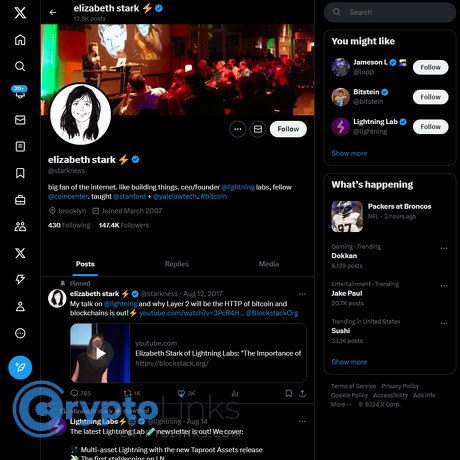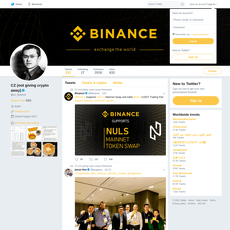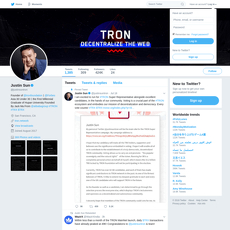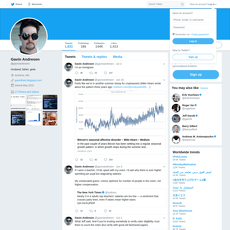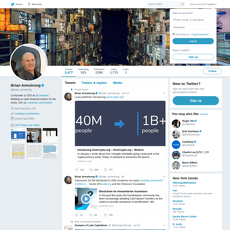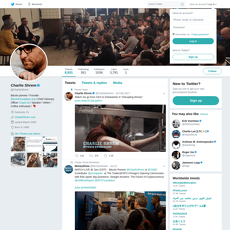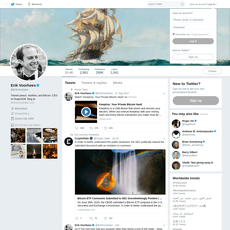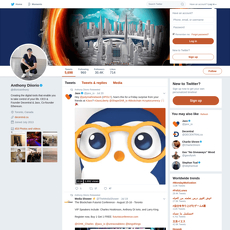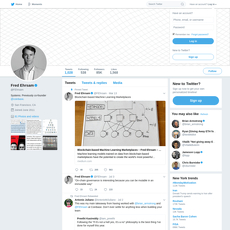elizabeth stark Review
elizabeth stark
x.com
Elizabeth Stark (@starkness) on X Review Guide: What to Expect, Why It Matters, and FAQ
Is following Elizabeth Stark on X actually worth your time—or just another distraction in a sea of crypto noise?
If you care about Bitcoin’s Lightning Network, real signals over hype, and staying early on credible infrastructure updates, this guide is for you. I’m going to show you what you’ll really get from @starkness, how I judge the quality of a crypto X account, and the simple tweaks that turn her feed into an edge without wasting your morning scrolling.
Key idea: You don’t need to follow everyone. You need to follow the right people—and set them up the right way.
The problem most people feel but can’t name
Crypto X is full of accounts that promise insight but deliver hype, hot takes, and recycled screenshots. That isn’t just annoying—it’s costly. Time lost to noisy feeds means fewer real decisions and missed technical signals that actually move products and ecosystems forward.
- Too much noise, too little substance: Threads without links, claims without sources, and commentary that never turns into code, docs, or product changes.
- Hard to verify: Lots of “big news” that doesn’t point to release notes, repos, BOLTs, or official posts.
- FOMO fatigue: You skim constantly, but rarely save anything actionable or traceable.
- Time sink: Even smart folks get caught in context switching. Research from the American Psychological Association highlights how task switching drains productivity and decision quality (APA).
- Misinformation risk: False signals travel fast on social platforms—one landmark study showed false news spreads faster than truth on X/Twitter (Science, Vosoughi et al.).
That’s the default experience. But it doesn’t have to be yours.
What you actually want (and rarely get)
- Credible primary sources: Posts that link to official repos, specs, or company blogs.
- Early ecosystem signals: Updates that hint at what’s shipping soon, who’s integrating, and where standards are heading.
- Consistent track record: Announcements that turn into releases, talks, or partnerships—not just threads that farm engagement.
- Actionable format: Posts you can save, tag, and plug into a research or product workflow.
Here’s my promise
I’ll show you exactly what Elizabeth Stark (@starkness) tends to post, who it’s useful for, how to filter it, and the quick setup I use so you catch the high-signal items without babysitting your feed. You’ll leave knowing if this follow is right for you—and if it is, how to make it pay off.
What this review covers (so you get value fast)
- What to expect in her feed: Product and protocol updates, Lightning ecosystem progress, standards talk, event signals, and policy/education notes focused on real-world use.
- Why it matters: If you’re building, integrating, or researching Bitcoin’s scaling layer, catching early Lightning cues can be the difference between reacting late and shipping on time.
- How I score signal vs. noise: I weigh primary sources, code/release links, collaborator tags, and whether posts lead to tangible outcomes.
- Workflow tips that actually save time: The follow-and-filter setup I use on X so important posts rise to the top and everything else gets skimmed.
Real examples you can expect to see
To set expectations, here are the kinds of posts from @starkness that typically carry signal:
- Lightning releases and specs: Links to Lightning Labs updates (think Taproot Assets milestones, L402/payments-for-APIs discourse), with pointers to docs or repos.
- Ecosystem coordination: Mentions of wallet/exchange/payment partners integrating Lightning features—often a leading indicator for broader adoption.
- Conference moments that matter: Clips or threads from major Bitcoin events where new work is presented, standards are debated, or timelines are clarified.
- Education with context: Clear explanations of why a change matters for fees, UX, routing, or the developer stack.
Example pattern: when Taproot Assets milestones moved forward in 2023, X was the first place many saw it from credible sources—paired with links to official posts and docs. That’s the kind of “save-worthy” item you want in your workflow.
Why this approach works
A high-signal follow + a sane setup gives you three real advantages:
- Early awareness: You’ll often catch Lightning movement before blog summaries and newsletters land.
- Better decisions: Links to repos and specs mean you’re not guessing—you can verify.
- Less scrolling: You’ll only get pinged when the content looks like a release, spec, or ecosystem action—not every reply or retweet.
If an X post doesn’t link to a primary source—or clearly preview one—it’s commentary. Save it if you want, but don’t let it hijack your roadmap.
Ready to sort out whether this follow fits your stack? Up next, I’ll share who Elizabeth is, where her perspective comes from, and why her X account is often early and technical. Want the quick snapshot before you decide to hit follow?
Who is Elizabeth Stark—and why her X account matters
If you care about Bitcoin actually working at internet speed—real payments, real apps, real users—then you’ve probably bumped into Elizabeth Stark. She’s the co-founder and CEO of Lightning Labs, one of the core teams shipping Lightning Network infrastructure used by wallets, exchanges, and payment companies worldwide. Her X handle, @starkness, sits close to where standards get discussed, releases go live, and integrations quietly turn into on-chain reality.
“Signal beats noise. Every time.” That’s the filter I use—and @starkness passes it.
Quick bio and role in the Bitcoin ecosystem
Elizabeth is best known for building Lightning Labs alongside Olaoluwa Osuntokun (lnd’s lead). Their stack powers a big chunk of Lightning: the lnd node, tools like Loop/Pool/Terminal for liquidity and operations, and new rails such as Taproot Assets (formerly Taro) for issuing assets that settle on Bitcoin. She also champions L402 (paid API access using Lightning) to let apps meter usage in small increments—think “pay a few sats for an AI inference or a single API call.”
Why that matters: Lightning aims to solve Bitcoin’s biggest user-facing pain—scalability—by enabling fast, low-fee payments while keeping settlement rooted in Bitcoin’s security model. When the person leading one of the primary Lightning implementations posts something, it often foreshadows code shipping, standards maturing, or new integrations going live.
If you want a data point for why this corner of crypto isn’t just theory, check adoption numbers. River’s 2023 report estimated routed Lightning payments grew over 1,200% from 2021 to 2023—quiet, steady, real-world usage. That’s the current that Elizabeth’s updates tend to trace.
What makes @starkness influential
Her posts skew builder-first and point to primary sources. You’ll see:
- Release signals: lnd updates, Taproot Assets milestones, and tooling improvements with links to repos or release notes.
- Standards and ecosystem progress: conversations around BOLT specs, LNURL patterns, channel liquidity work, and interoperability. Often she highlights the people doing the work, not just the headlines.
- Real-world integrations: payment use cases, API monetization with L402, and infrastructure partnerships that hint at where merchant and developer demand is heading.
- Conference/talk threads: talk announcements, slide links, and event clips from Bitcoin conferences—useful for catching roadmap themes without watching full streams.
Cadence isn’t “post every hour.” It’s closer to “post when there’s movement.” When Taproot Assets’ mainnet alpha was announced, her thread pointed to official docs and examples; when significant lnd versions land, she typically threads the highlights and links to changelogs. That’s the kind of signal that saves time.
Who benefits most from following
- Developers: Early heads-up on releases, breaking changes, and specs. Links to repos mean you can jump straight into code or docs.
- Infrastructure founders: Clues on timing for integrations (e.g., Taproot Assets support), liquidity strategies, and where demand is forming in the payment stack.
- Payment startups/wallet teams: Practical context on fees, routing, and UX friction points, plus examples of how others are using Lightning in production.
- Bitcoin power users/node ops: Posts that hint at when to update, what to test, and which features are worth trying on your setup.
- Researchers/analysts: Credible pointers to standards debates, adoption metrics, and cross-implementation work you can verify via BOLTs or public repos.
Where her perspective fits in your information stack
I treat @starkness as an early-warning system for Lightning infrastructure—not a price feed and not a meme stream. Her posts help me decide when to:
- Open release notes and plan upgrades.
- Bookmark standards discussions to monitor (BOLTs, LNURL conventions, channel management advances).
- Watch one talk instead of skimming ten unrelated threads.
- Flag roadmap items around Taproot Assets or L402 if payments and API monetization matter to my product.
The emotional upside is real too: it’s energizing to see progress from people actually shipping. When she highlights contributors and concrete milestones, it cuts through the doom-scroll and reminds you why Bitcoin’s scaling work is worth following.
Curious what her posts actually look like in your feed—what topics repeat, what to save, and what to skim in seconds? Up next, I’ll show you the patterns and a few tell-tale signs that a post is worth opening right now.
What you’ll actually see on @starkness
Open her feed and you’ll notice a pattern fast: less price talk, more shipping. If you care about where Lightning is actually moving, this is where you catch the “what’s being built” signal as it lands.
“Less noise, more signal. Follow the commits, not the comments.”
Content types you can expect
Here’s the kind of posts that show up again and again—and what they mean for you:
- Product and protocol updates — Links to lnd releases, Taproot Assets milestones, and L402/“pay-per-request” tooling like Aperture. Expect phrasing like “now live,” “beta,” “release notes,” or “mainnet.”
- Ecosystem partnerships and integrations — Wallets, payment processors, exchanges, or API platforms adding Lightning or Taproot Assets support. These posts often tag multiple teams and include a link to docs, which is your cue that it’s real—not vapor.
- Standards and specs context — Mentions of BOLT discussions and interoperability work, often pointing to the BOLTs repo or technical notes. If you build on Lightning, these posts help you prepare for upcoming changes.
- Conference highlights — Short threads from events like Adopting Bitcoin, TABConf, or major Bitcoin conferences. Look for slides, panel clips, or a summary thread that links to a talk or deck.
- Policy and education — Clear, grounded explanations when fees spike, channels get stressful, or UX friction appears. The tone is typically practical: why it matters and what’s being tested to fix it.
Real sample patterns I watch for:
- “We just shipped…” with a link to GitHub releases, a changelog, or Lightning Labs’ blog.
- “Available to developers today” with docs and example code.
- “Partnering with X to enable Y” with both teams posting in the same hour.
Signal vs. noise
Not every post needs your full attention. Here’s how I sort must-saves from skim-worthy in seconds:
- Must-save (bookmark these):
- Release notes, tagged versions (e.g., vX.Y.Z), or “now live” language.
- Links to primary sources: github.com, lightning.engineering, official docs, or recorded talks with slides.
- Spec talk or implementation details that reference issues/PRs in the BOLTs repo.
- Coordinated posts across multiple credible teams on the same feature or rollout.
- Nice-to-know (skim and move on):
- Conference photos without links to talks or slides.
- High-level encouragement or “state of the space” commentary without concrete next steps.
- Media appearances summarized without a resource link.
Why this works: research shows engagement-heavy content isn’t always the most accurate or useful. The MIT study “The spread of true and false news online” (Science, 2018) found false news travels faster than true news on social platforms. I put more weight on posts that include verifiable artifacts—code, docs, specs, and reproducible demos—because they’re harder to fake and easier to build on.
Tone and level: who gets the most value
- Technical, mission-focused — You’ll see clarity on scaling, UX friction, and interoperability rather than price predictions.
- Builders and infra teams — Likely to benefit the most; you can time your integration work around release patterns and spec signals.
- Long-term Bitcoin users — Get ahead of wallet features, fee dynamics, and payment UX improvements.
- Traders — Treat it as macro context and milestone timing. It won’t tell you what to buy, but it can hint at narrative waves (e.g., new Lightning capabilities hitting mainnet).
How to spot high-value posts fast
When I’m tight on time, I scan for these tell-tales:
- Primary links — GitHub repos, official docs, or blog posts with changelogs, like:
- lnd release notes
- Taproot Assets releases
- BOLT spec discussions
- LNURL standards (LUDs)
- Action verbs — “shipping,” “now live,” “beta,” “mainnet,” “merged,” “RFC,” “spec update,” “integrated,” “open-sourced.”
- Slides or code snippets — Threads with attached decks, diagrams, or example requests (e.g., L402 headers for API payments) usually signal something you can test today.
- Cross-team coordination — Multiple wallets/exchanges/APIs posting the same hour about a feature. That’s your early adoption window.
- Calls for testers — “Try it and send feedback” is a strong indicator of near-term release and a chance to shape the roadmap.
One more trick: if a post links to a repo and you see issue chatter in the last 48 hours, it’s not just a marketing moment—it’s an active push. That’s where real edges come from.
Curious how I score credibility, originality, and follow-through so you don’t waste time on fluffy threads? In the next section, I break down the exact review criteria I use to separate signal from polish—want the checklist?
My review criteria: how I evaluate crypto X accounts
There’s a simple test I use for any crypto account I’m thinking of trusting with my attention: can I verify what I just read in under 60 seconds? If the answer is yes, that account earns a spot in my research flow. Here’s the framework I use to judge whether an X feed is signal—or just a slick distraction.
Credibility and transparency
I’m looking for posts that point me to facts I can check, not takes I need to believe. In practice, that means:
- Primary sources over screenshots: Links to official repos, specs, or docs. For Lightning, that usually looks like:
- lnd release notes (GitHub)
- BOLTs spec repo
- Lightning Labs blog
- Core Lightning (CLN) repo
- Named collaborators and context: Clear attribution to teams, maintainers, or partner projects involved in the update.
- Concrete, testable claims: Version numbers, PRs, tagged releases, dates for talks, and links to recordings or slide decks after events.
- Safety-forward language: Notes on limitations, beta status, or migration steps when changes affect users or devs.
Why I care about this so much: research shows false or sensational claims travel faster than the truth on social platforms, especially in tech and politics. One well-cited study found that false news spreads “significantly farther, faster, deeper, and more broadly” than the truth on Twitter/X (Science, 2018). Linking to primary sources is the simplest antidote.
“In crypto, screenshots are opinions; links are facts.”
Original insight vs. promotion
Not all posts are created equal. I score them on how much new signal they add:
- 3 – Original and actionable: First-party release notes, new specs, ecosystem coordination (e.g., multiple projects aligning on an upgrade), or implementation details devs can use.
- 2 – Context with value: Threaded explanations, comparisons, or roadmapping that clarify why something matters and what to expect next.
- 1 – Routine amplification: Reshares without commentary, generic event hype, or vague announcements (“big things coming”).
- 0 – Noise: Price talk, memes, or off-topic replies that don’t inform product decisions or research.
When I see an announcement that links to a GitHub tag, a spec PR, and a blog explainer, I put it in the “3” bucket and archive it in my notes immediately. A retweet without context stays on the timeline.
Engagement quality over vanity metrics
Likes are easy to game. Credible discussion isn’t. I skim the replies and quote posts for who’s engaging and how:
- Who’s in the thread? Maintainers, wallet builders, researchers, and infra founders. If I see devs from multiple implementations (e.g., lnd and CLN) adding details or asking pointed questions, that’s a green flag.
- Do replies add technical value? Links to code, perf benchmarks, migration notes, or edge cases signal a high-signal conversation.
- Is there respectful pushback? Healthy disagreement backed by references beats a pile-on of cheerleading any day.
Broadly, people over-index on big numbers and underweight expert interaction. That’s risky. Pew Research has repeatedly shown how social feeds distort perceived consensus and news quality (Pew, 2021). I filter for expertise, not volume.
Track record and consistency
I don’t just score the post—I watch the follow-through:
- Release gravity: Do teased features or partnerships show up later as code, docs, or shipped products?
- Theme consistency: Are they consistently focused on Bitcoin scaling, Lightning infra, and payments UX—or do they drift into unrelated content when engagement dips?
- Time-to-proof: How long between “we’re working on X” and something I can test or read? A shorter, predictable arc builds trust.
- Corrections and updates: When details change, do they acknowledge it and point to the latest source?
Over a multi-quarter window, I map claims → commits → releases → adoption signals (conference talks, wallet integrations, partner posts). If that loop closes reliably, I keep the alerts on.
My at-a-glance scoring rubric
- Source: Linked repo/spec/blog or it didn’t happen.
- Substance: Specifics beat slogans—versions, PRs, dates.
- Signal: Are builders and researchers engaging with useful additions?
- Follow-through: Did it ship, and can I verify it today?
This is the filter I use to judge whether an X account is worth my notifications. Want the practical setup I use to catch high-signal posts without getting overwhelmed—alerts, Lists, and a few search strings that surface the good stuff first? Keep going—ready to turn this into a zero-noise feed in under five minutes?
Get the most value: alerts, lists, and smart search
I want signal, not dopamine loops. The trick is to architect your feed so high-value Lightning updates reach you without stealing your day. Set it up once, and it keeps paying you back.
“A wealth of information creates a poverty of attention.”
— Herbert A. Simon
The follow setup I use
This is a simple, fast configuration that consistently surfaces Lightning-relevant posts and cuts the noise:
- Create a private List named “Bitcoin Infra.” Add @starkness. Pin the List so it sits one tap from Home.
- Enable “Posts + Highlights.” On @starkness’s profile, tap the bell and choose Posts + Highlights. You’ll catch meaningful updates without buzzing for every like or reply.
- Optional: turn off retweets for @starkness. This keeps the feed focused on originals. You can always check the List for wider context.
- Star key terms in your notes:Lightning, LNURL, L402, Taproot-related scaling. Keep one running note titled “Lightning Watch” with three buckets: Releases, Specs/Standards, Partners/Integrations. Paste links under the right bucket. You’ll thank yourself in a month.
- Noise control: Mute words that commonly bait crypto users: giveaway, airdrop, support, helpdesk, investment advice. Settings → Privacy and safety → Mute and block → Muted words.
Why this works: research from Nielsen Norman Group shows people scan feeds in patterns and lock onto keywords. Lists, highlights, and saved queries bias your attention toward the few items that matter.
Power-user search queries
These links open pre-filtered searches so you can jump straight to the good stuff:
- Releases and go-live signals:
from:starkness “release” OR “now live”
Why: Fast way to spot shipped changes or features hitting production.
- Posts with links:
from:starkness filter:links
Why: Filters to external sources—blogs, repos, videos—so you can validate at the origin.
- High-engagement signals:
from:starkness (Lightning OR “layer 2”) min_faves:50
Why: Surfaces posts with stronger traction—helpful when you’re short on time.
- Specs and standards talk:
from:starkness (BOLT OR BOLTs OR spec) -filter:replies
Why: Threads about standards often foreshadow changes builders will feel next.
- Github or official domain links:
from:starkness url:github.com/lightninglabs OR url:lightning.engineering
Why: Primary sources only—best for verifying claims quickly.
- Fresh-only window:
from:starkness since:2025-01-01 -filter:replies
Why: Snap to recent updates when you’re catching up after a break.
Save each search (tap the three dots → Save search). On desktop, keep them in a bookmarks folder named “Starkness” so they’re one click away.
Two-minute weekly routine
I run this every Friday—fast, repeatable, no rabbit holes:
- Open the Releases/go-live search first. If there’s a new repo, PR, or blog post, drop it into your “Lightning Watch” note.
- Scan the Specs/standards search. If there’s BOLT talk, tag it “Watch” and set a calendar reminder in 2 weeks to check progress.
- Glance at the High-engagement search. If a post has unusual traction, ask: Does this change my roadmap, risk model, or integration timeline? If yes, star it and add a one-line takeaway in your note.
That’s it. Two minutes. If there’s nothing, you’re done. If there is, you won’t miss it.
Make it effortless on desktop and mobile
- Pin your “Bitcoin Infra” List. On mobile, it keeps your home feed clean; on desktop, it becomes your dedicated Lightning column.
- If you use X Pro (TweetDeck): add columns for the three saved searches above. Color-code them: Releases (green), Specs (blue), High-engagement (orange). Visual cues reduce scanning time.
- Use “Turn off notifications at night.” Keep the highlights, but protect your focus. Important posts will still be there in the morning.
Quick filters that save you hours
- Quality filter: Enable X’s Quality filter in Notifications to weed out low-quality replies under high-signal posts.
- Only alerts from people you follow: Turn off push notifications for “Recommendations” and “Spaces you might like.” You’re here for updates, not discovery.
- Reply scanning trick: When a release is posted, open the tweet and search within it for “issue”, “PR”, “breaking”, “migration”. It surfaces immediate dev concerns and upgrade notes.
Small note on attention: studies on digital work show that batching checks dramatically improves retention and reduces context switching. This system is built to batch by design.
Stay safe from impersonators
Crypto scams love piggybacking on real announcements. Simple habits keep you safe:
- Always verify the handle: @starkness exactly. Similar usernames can look convincing at a glance.
- Trust domains you can audit: links to lightning.engineering, blog.lightning.engineering, or github.com/lightninglabs are your safest bet.
- Never act on DMs about grants, airdrops, or “support.” Real updates are public, link to official domains, and don’t require you to connect a wallet or send funds.
- Watch out for reply scams under popular posts. QR codes, “claim” links, or fake “help” accounts are common tricks. If in doubt, navigate to the official site manually.
Chain analysis firms have repeatedly noted social platforms as a major vector for crypto scams—treat anything financial in replies or DMs as hostile until proven otherwise.
Want to go even faster?
- One-tap summary: Keep a browser bookmark folder with your three saved searches. Open All in Tabs when you sit down to work.
- Highlights-only mindset: If you’re in shipping mode, only check the Releases/go-live search. Everything else can wait.
- Personal glossary: When you hit a new term (e.g., L402), add a one-sentence definition in your note with a source link. Next time, you won’t stall.
Set this up once and your attention stops getting hijacked. You’ll catch the posts that matter, skip the ones that don’t, and feel in control of your feed again.
Still wondering what kinds of sources she shares most, how often updates land, or whether this setup is overkill for traders vs. builders? I’ve got quick answers to those exact questions next—want the straight take?
FAQ: People also ask about Elizabeth Stark and @starkness
Who is Elizabeth Stark?
Elizabeth Stark is a leading voice in Bitcoin scaling and the co-founder/CEO of Lightning Labs. She’s closely tied to the teams building and shipping core Lightning tooling—think lnd, Taproot Assets, and specs around Lightning-based authentication and payments. If you care about real-time signal on where Bitcoin payments are headed, she’s one of the earliest sources to watch on X.
What is the Lightning Network and why should I care?
Lightning is a payment network that sits on top of Bitcoin to make transactions fast and cheap. Instead of writing every payment to the blockchain, it uses payment channels and cryptographic guarantees to settle instantly and batch the heavy lifting later. For everyday payments, machine-to-machine billing, or exchange-to-exchange transfers, Lightning can remove friction and fees.
Independent research and industry reports consistently find that Lightning payments succeed with low fees at small amounts—exactly where on-chain Bitcoin struggles. You’ll see @starkness highlight improvements that make those wins more reliable and easier to integrate.
Is @starkness worth following for traders?
Yes, but with the right expectations. You won’t get price calls. What you do get is timing insight around technical milestones—new releases, wallet integrations, or standards that can shift narrative and user experience. For example:
- Release posts for lnd or Taproot Assets often precede integration news from wallets and exchanges.
- Conference highlights can hint at near-term priorities (routing reliability, fees, security hardening) that affect adoption pace.
For traders, that’s macro context and narrative timing—not trade signals.
Is @starkness better for builders and founders?
Absolutely. Expect posts that inform real product decisions: SDK updates, compatibility notes, ecosystem partnerships, and authentication/payment patterns like L402 for machine-payments. Example posts you’ll typically see:
- “New release is out” with links to GitHub and changelogs.
- “Taproot Assets update” with dev docs and migration notes.
- “AI + Lightning” demos showing pay-per-request or metered APIs with Lightning-based auth.
Builder heuristic: If a post includes release notes, repos, or a spec discussion, bookmark it—these are the ones that influence roadmaps.
Does she post often?
Cadence varies. You won’t get daily fluff. When updates land, they’re usually tied to meaningful progress: a new version, a spec conversation, a major event, or a notable integration. If Lightning is core to your product, turn on notifications and skim highlights; it’s a low-time, high-signal follow.
What kind of sources does she share?
Mostly primary sources and ecosystem work:
- Official posts and blog updates from Lightning Labs.
- GitHub releases and repos (lnd, Taproot Assets, tooling).
- Conference talks, panels, and event clips.
- Standards/specs and collaboration announcements across Lightning teams.
That mix keeps you close to the ground truth—docs, code, and talks—rather than commentary.
How do I keep up without getting overwhelmed?
- Create a small List called “Bitcoin Infra” and add @starkness plus 5–10 core infra accounts max. Keep it tight.
- Enable notifications for Posts + Highlights, not all replies.
- Save two searches you run weekly:
- from:starkness “release” OR “now live”
- from:starkness filter:links
- Build a running note where you paste only posts with links to repos, release notes, or specs. That’s your rolling changelog.
How do I avoid scams or fakes?
Simple checks save headaches:
- Verify the handle: it’s @starkness. Watch for look‑alike characters.
- Check the link domain before clicking. Legit links typically point to lightning.engineering, github.com/lightninglabs, or github.com/lightningnetwork/lnd.
- No DMs for money or “support.” Real announcements and grants are public and verifiable. If a message pushes urgency, it’s almost always a scam.
- Avoid airdrop bait. Lightning Labs and reputable teams don’t run surprise airdrops via DMs or reply threads.
If something feels off, open a fresh tab and navigate to the official site yourself—never through a random shortened link.
What’s the practical value I can expect in the next quarter?
I’d expect more on performance, routing reliability, mobile UX, and programmable payments (like usage-based APIs). Historically, when these areas see movement, you’ll see coordinated posts across devs, repos, and event talks—exactly the kind of breadcrumbs @starkness surfaces early.
Want the quick verdict on who should follow vs skim—and the exact setup to turn her feed into an advantage? That’s next.
Is following @starkness right for you?
If you care about real progress on Bitcoin’s scaling layer, following @starkness is one of the easiest wins on X. The feed is lean, technical, and usually tied to something shipping, something integrating, or something moving in standards. It’s not a price feed—it’s an execution feed.
My verdict
- Must-follow: builders shipping on Bitcoin/Lightning, infra-focused founders, node operators, payment startups, and researchers. You’ll catch release signals, partnership momentum, and standards chatter that actually affects roadmaps.
- Follow + skim via Lists: long-only crypto investors, fund analysts, and product managers watching BTC payments. You’ll get timing context around milestones (e.g., when an exchange flips on Lightning withdrawals or when a new spec gets traction).
- Rely on summaries: casual users who just want to know when Lightning adoption expands. In that case, keep a curated List and check it monthly—or read roundups from sources like Bitcoin Optech.
What you’ll catch early (real examples)
- Protocol and product releases: Links to repos and blog posts for things like LND updates or Taproot Assets iterations often appear here quickly, with context that helps you judge readiness. Example: Taproot Assets announcements typically include docs or release notes from Lightning Labs’ blog, which is a high-signal cue to test or integrate.
- Ecosystem integrations: When major services enable Lightning (think exchanges or apps adding LN deposits/withdrawals), you’ll often see confirmation or framing that hints at how serious the rollout is—pilot vs production, region limitations, fee setups.
- Standards and coordination: Pointers to BOLTs progress, LNURL and L402/LSAT-style patterns, or interop updates. These posts help you predict what wallets, services, and APIs will prioritize next. If you’re building, this can save you weeks.
- Conference moments that matter: Short clips or threads from events like Adopting Bitcoin, Baltic Honeybadger, and Scaling Bitcoin capture where the conversation is moving—especially around UX, routing reliability, and fee economics.
Quick note on quality: research on web credibility from Nielsen Norman Group shows that linking to primary sources boosts trust and comprehension. That’s the norm here: you’ll usually get repos, docs, or official posts—exactly what you need to verify and act.
Action plan: minimal setup that actually works
- Follow @starkness and enable Posts + Highlights notifications. No need for all replies—keep it clean.
- Add to a “Bitcoin Infra” List with a few other high-signal accounts. Read that List when you need focused context, not during random scrolls.
- Save two searches:
- from:starkness filter:links (surfaces posts that point to releases, docs, or talks)
- from:starkness (Lightning OR “layer 2” OR Taproot) min_faves:50 (floats posts with traction)
- Start one running note: “Lightning: Stuff to test/track.” Every time you see a post with repos or release notes, drop the link and a one-liner on what it could change for your product or research plan.
How I keep it from wasting time
- Scan for links first: repos, release notes, or docs = high signal. Commentary without links = skim and move on.
- Batch once a week: run your saved searches and process anything you missed in 10 minutes. Add only what affects your roadmap.
- Watch who engages: when devs, wallet teams, or protocol contributors reply, that post probably matters. (Edelman’s Trust Barometer has long shown experts are the most trusted; in crypto, expert engagement is a strong quality filter.)
- Stay scam-safe: always check the exact handle (@starkness) and verify linked domains before clicking. No grants, airdrops, or “support” in DMs—ever.
“Treat this feed like a changelog with commentary. If there’s a repo, spec, or integration link, that’s your cue to pay attention.”
Bottom line
Yes if you build on Bitcoin or care about the Lightning Network beyond headlines. You’ll get credible, early signals and the kind of context that helps you ship the right thing at the right time. If you’re trading short-term, use it for timing around tech milestones—not entries and exits. If you’re casual, keep it in a curated List and check in monthly.
Keep the setup simple, protect yourself from impersonators, and focus on posts that link to primary sources. Do that, and you’ll turn this follow into real-world advantage without getting stuck in the feed.
CryptoLinks.com does not endorse, promote, or associate with Twitter accounts that offer or imply unrealistic returns through potentially unethical practices. Our mission remains to guide the community toward safe, informed, and ethical participation in the cryptocurrency space. We urge our readers and the wider crypto community to remain vigilant, to conduct thorough research, and to always consider the broader implications of their investment choices.

